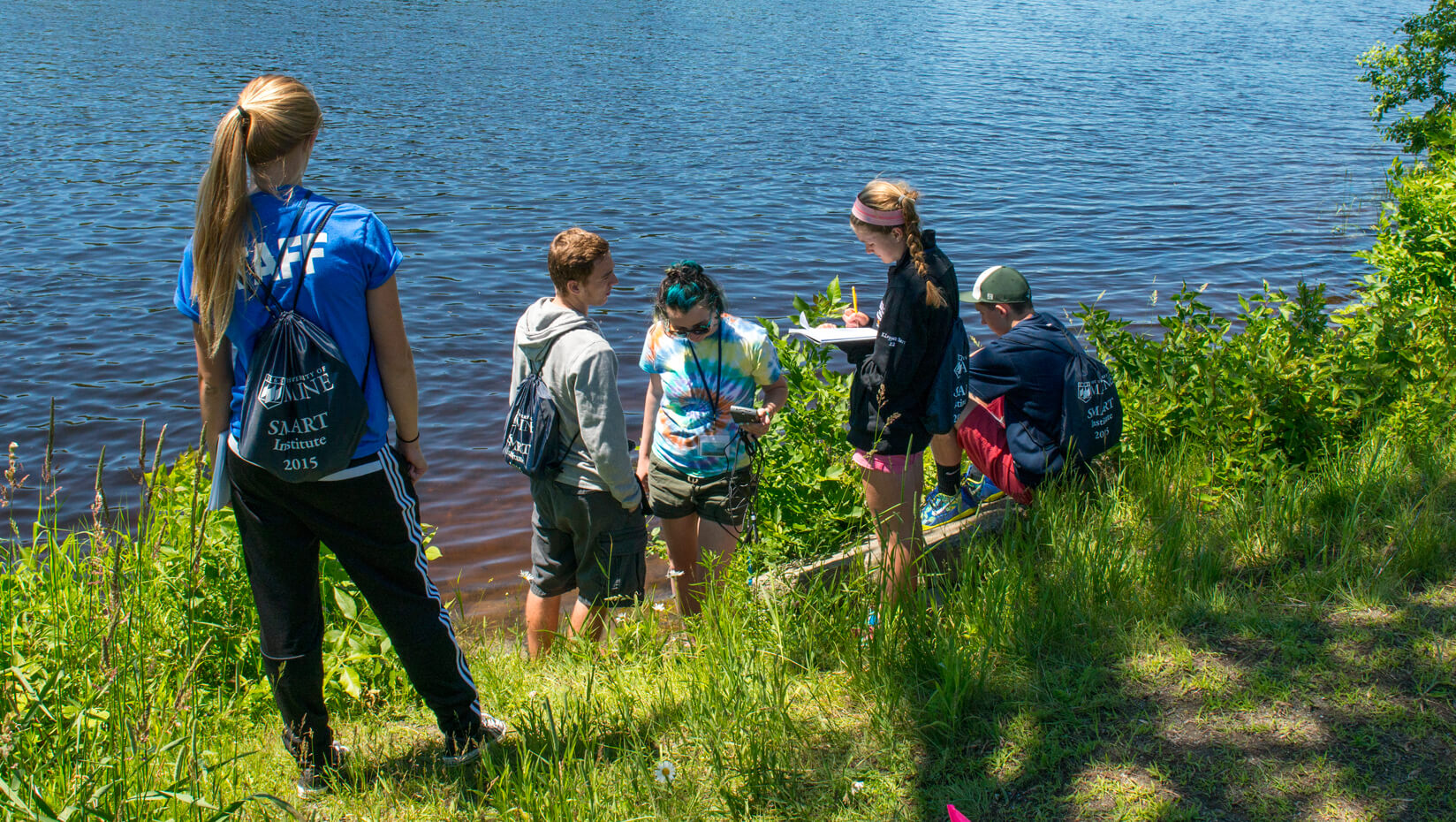
High school students to study stormwater management at annual UMaine institute
About 85 high school students and nearly 20 teachers from around Maine, as well as other parts of the country, will gather at the University of Maine for a multiday program that focuses on creating innovative solutions to environmental problems related to stormwater management.
Students from 16 high schools in Maine and one in both New York and Missouri will work with university faculty, undergraduate and graduate students, city and state planners, engineering consulting companies, nonprofit organizations, teachers and community leaders during the UMaine Stormwater Management Research Team (SMART) Institute that runs from Sunday, June 26 through Wednesday, June 29.
Now in its third year, the SMART program aims to engage a diverse group of students and teacher-mentors in training for the implementation of science, technology, engineering and mathematics (STEM) in their schools while addressing an important environmental issue. Stormwater runoff is a pressing and expensive problem for most major cities, and the model of the program — STEM solution-focused with diverse citizen involvement — has nationwide applicability and appeal, program organizers say.
This is the first year out-of-state high schools have been involved in the program. Conference presentations by SMART project leaders and other publicity have contributed to an increased national interest in the program.
The institute at UMaine kicks off a yearlong program for students and teachers by introducing them to the science and engineering of stormwater management, including its impact on the environment and local economy.
At the conference, students will collect water samples on the Stillwater River, analyze that data, build their own digital temperature sensors and present their findings at the end of the institute.
The hands-on projects are led by STEM professionals in areas such as engineering design, water chemistry, data analysis and visualization and information technology. Participants will tour UMaine labs and stormwater areas on campus, as well as the Orono wastewater treatment facility.
Throughout the academic year with their teacher-mentors, students are required to apply the skills they learned during the institute to research a local water body and perform outreach to younger students and their community.
An opening session will be held 8–9 a.m. Monday, June 27 in the Hill Auditorium of Barrows Hall. Jeffrey Hecker, UMaine’s executive vice president for academic affairs and provost, is expected to welcome the participants.
Paige Brown, a 2014–2015 SMART Institute participant and recent Bangor High School graduate, will deliver the keynote address for the second year. Brown’s talk, “Constructing Inexpensive Calcium Alginate Based Scaffolds for Phosphate Sorption,” will contain a review of her stormwater remediation research project.
In March, Brown received one of three first-place awards — worth $150,000 — from Intel Science Talent Search, a national competition recognizing the brightest young minds in science. Brown, who invented a device for improving water quality, won the First Place Medal of Distinction for Global Good, which recognizes a finalist who demonstrates great scientific potential through their passion to make a difference. Among numerous other awards, she also is the recipient of the 2015 Maine Stockholm Junior Water Prize, a prestigious youth award for a water-related science project.
While participating in SMART, Brown studied the water quality of six environmentally impaired local streams with high E. coli levels and five with high phosphate contamination levels.
The final day of the institute, June 29, will include student presentations and a closing ceremony in Hill Auditorium at 1 p.m.
The SMART Institute is open to 10th- and 11th-grade students. Females and minorities are strongly encouraged to apply. The program, which is offered in collaboration with Bangor High School, also trains high school teachers to co-facilitate the academic-year internships.
This year’s participating Maine high schools include Bangor, Portland, South Portland, Calais, Old Town, Orono, Lewiston, Searsport District High School, Belfast Area High School, Edward Little in Auburn, Greely in Cumberland, Deering in Portland, Shead in Eastport, R.W. Traip Academy in Kittery, Leavitt Area High School in Turner and Washington Academy in East Machias. Two teachers and five students from Lincoln High School in Yonkers, New York and Camdenton High School in Camdenton, Missouri also are expected to attend.
The institute is supported by a more than $735,000 grant awarded by the National Science Foundation’s Experimental Program to Stimulate Competitive Research (EPSCoR) Track III program that aims to empower female and minority high school students who are often underrepresented in STEM fields. The program also is supported by Emera Maine, Maine Community Foundation (Haskell-Stetson Trust), Bangor Savings Bank and IDEXX Corp, as well as Carlton W. Ellms ’71 and Sally Devereux Ellms ’70.
The SMART program has been recognized nationally by the Institute of Electrical and Electronic Engineers’ (IEEE) InSight magazine as a “Model for Boosting STEM Literacy” and will appear in the upcoming issue of ChemMatters magazine produced by the American Chemical Society. IEEE also recognized Mohamad Musavi, SMART director and associate dean of the College of Engineering at UMaine; and Cary James, head of the Bangor High School science department, with its national K–12 STEM Literacy Educator-Engineer Partnership Award in 2014.
Musavi says he has been encouraged by the National Science Foundation (NSF) to propose a plan for scaling up the project nationally and has been invited to present at the NSF Distinguished Speaker Series.
Contact: Elyse Kahl, 207.581.3747
